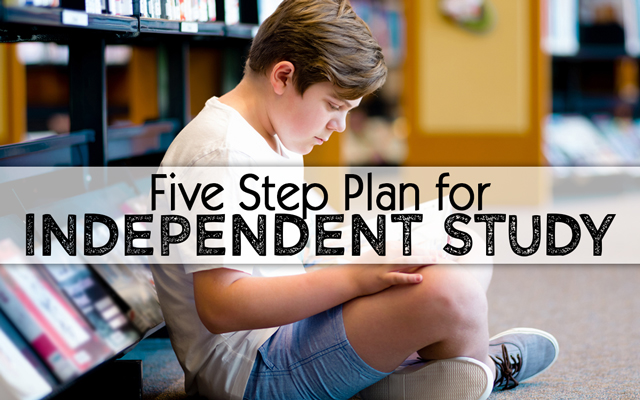Five Step Plan for Independent Study


One of my goals in homeschooling is to encourage my children to become lifelong learners. I desire that my kids pursue their interests and learn continually throughout their lives. Completing an independent study is a great way for students to learn about something outside of their regular curriculum or to expand on a topic that they have learned. Here are five steps to plan a successful independent study. You can find a free planning form at https://sharedlessons.org/free-downloads/
Since this is an independent study, and the goal is for your child to learn independently, it is important that your child creates the plan. Depending on the age of your child, you may need to offer assistance. Even if your child is older, I suggest that you sit down together and review the planning steps to make sure that everything is clear. By the end of the planning process, both you and your child should know what is expected from the study and how it will be accomplished.
Step 1: Choose a topic or course name and write a brief description. This should be just a general course description. Suppose your child wants to learn about computer animation, then the course name could be “Computer Animation” and the description could be as simple as “I will learn about computer animation and how to create an animated image.”
Step 2: Make a list of specific goals. What will your child know when the study is completed that he or she doesn’t know now? What will your child be able to do? This is the place to clearly identify what it is that the student wants to learn. There are several factors that may help determine how many goals to set. How long will the study last? Are you giving your student a short deadline for completion? If so, then you may want to limit the number of goals. How complicated is the topic? I suggest listing at least three goals to help the student feel a sense of progression as he or she completes the study.
Step 3: Plan how to achieve each of the goals. Will your child conduct research, do experiments, or practice a new skill? Are field trips required? How much time will be spent on achieving each goal? How much time will be spent on the study each day, each week, in total? Will your child be required to check-in with you at set intervals?
Step 4: Figure out what resources are needed. Will your child need to visit the library to find books or other materials? Is a computer program needed? Will supplies need to be purchased or borrowed? This step is also a reality check. If the resources needed can’t be easily acquired, the goals may need to be altered.
Step 5: Determine how your child’s learning will be assessed. How will he or she be able to demonstrate that the goals have been achieved? Will there be a test or a research paper? Will there be a demonstration or a visual model? Will the study be graded? If so, what will be the basis for grading?
Planning an independent study can be a great lesson in and of itself. It teaches your child how to set goals and how to create a plan to successfully achieve them. This lesson can be used throughout life. As your child works on the study, I suggest checking in regularly to make sure your child is progressing. Adjustments may need to be made. Sometimes plans don’t work out, and that is an important lesson to learn, too. By all means, celebrate when the study is complete. It is a great achievement to learn something independently.
Heidi Kinney is a freelance writer and editor. Her background includes professional teaching in the area of mathematics, as well as writing and editing for several educational publishers. She has been homeschooling her children since 2007. She shares homeschool resources and lessons on her website, SharedLessons.org.










































